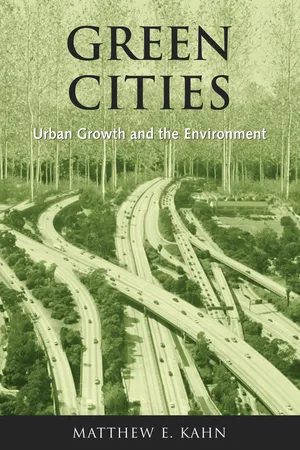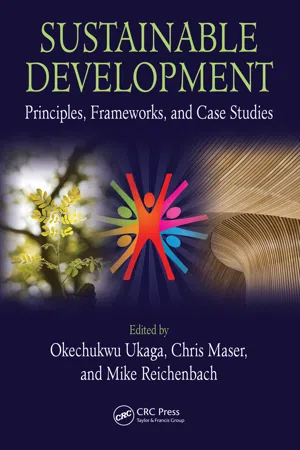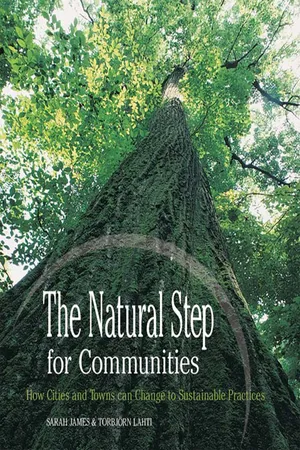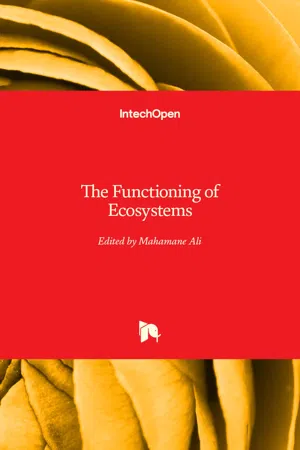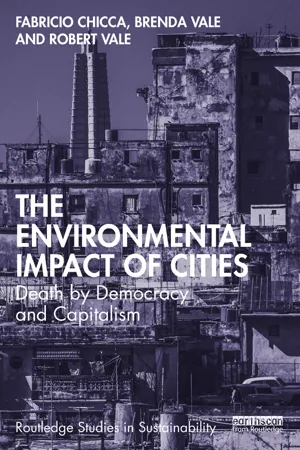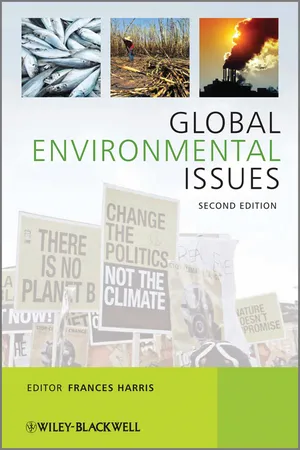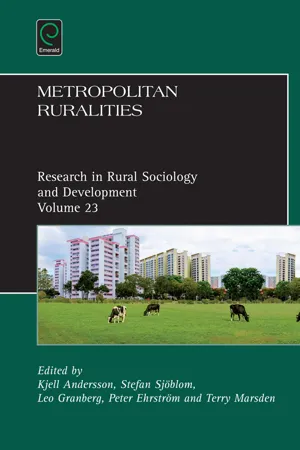Geography
Ecological Footprint of Cities
The ecological footprint of cities refers to the measure of the environmental impact of a city, including its consumption of resources and production of waste. It assesses the amount of land and resources required to support the city's population and activities, highlighting the sustainability challenges faced by urban areas. This concept is crucial for understanding and addressing the environmental implications of urbanization.
Written by Perlego with AI-assistance
Related key terms
1 of 5
12 Key excerpts on "Ecological Footprint of Cities"
- eBook - ePub
- Joe Ravetz, Clive George, Joe Howe, Peter W. Roberts(Authors)
- 2004(Publication Date)
- Routledge(Publisher)
The concept of ecological cycles in environmental science examines how flows of substances, such as water and carbon, continuously circulate through the biosphere. Cities tend to disrupt such natural and self-organising cycles with a ‘linear’ metabolism – natural resources are sucked in, and pollution and wastes are pushed out along with products and services. A city or region which contains its own ecological cycles in a ‘circular metabolism’ would tend to be less vulnerable and damaging, in other words more sustainable. For instance, one key cycle would be food which is locally grown, digested and its nutrients returned to the soil within the hinterland of the city. Even where the cycle is at a global scale, it can still be sustainable, if its side-effects or risks are contained within acceptable limits and thresholds.1.5 Ecological footprintsOne method that can be used to measure and express the quantity and pattern of the consumption of resources by urban areas has been developed through the application of the concept of the ‘ecological footprint’, sometimes called the ‘environmental shadow’. This concept, which allows for a meaningful and comparable measurement of the resources consumed by cities, has been defined as the ‘land required to feed them, to supply them with timber products and to reabsorb their carbon dioxide emissions by areas covered with growing vegetation’ (Smith, et al. , 1998, 20). The ‘ecological footprint’ is a helpful concept because it attempts to measure all the environmental consequences of urban living and consumption in a single consolidated statistic, usually global hectares of land per person. The component parts of the measurement include the direct consumption of energy, food, transport and other resources; the demand made upon land to grow and produce products; and the use made of other areas of land in order to satisfy human needs.Footprints of ‘North’ and ‘South’
Estimates vary of the ‘ecological footprint’ of individual cities, and research is continuing on the differences between urban and rural areas. However, at national level it is evident that the average North American’s ‘ecological footprint’ is five times the world average, and 20 times the ‘ecological footprint’ of the city dwellers in the poorest nations. Box 1.3 - Susan M. Opp, Susan M. Opp, Lauren C. Heberle(Authors)
- 2016(Publication Date)
- Routledge(Publisher)
This chapter is divided into six sections. In the following section we briefly outline the purpose of an Ecological Footprint. The third section notes the adoption of the Ecological Footprint as a sustainability indicator by the National Assembly for Wales and the promotion of the Footprint within Cardiff, the capital city of Wales. The next section outlines the nature of development in Cardiff’s International Sports Village (ISV) – the key development within the city. This is followed by a review of the Cardiff Ecological Footprint and the estimated Footprint of visitors to ISV. Finally, the chapter points out that despite the evidence that the Footprint produces of environmental impact, developmental pressures are likely to remain at the fore.What is an Ecological Footprint?
A Footprint provides a “snapshot” estimate or measure of the area of land and water ecosystems required to provide the resources and to assimilate the wastes of a given population. More simply stated, an Ecological Footprint indicates the demand on the environment for resources. Typically the population studied is that of a nation-state, however the Footprint can also be applied to a region, city (or other administrative area), business, person, or product. Politico-administrative areas are favored units for analysis because they have a defined geographical boundary that can then be compared to the Footprint area. By showing the impact of a population in terms of area, the Footprint provides a clear illustration of the ways in which “… biologically productive land area produces or absorbs flows of many of the materials utilized by our society. Uses are often mutually exclusive and are therefore in competition for the finite area of productive land in the world” (ECOTEC 2001). The Ecological Footprint has the potential to visualize human demands upon the environment in terms of the use of the earth’s available land making it an intuitive and attractive means of measurement.The Ecological Footprint is measured using a standardized area unit equivalent to a world average productive hectare or “global hectare” (gha) and is usually expressed in global hectares per person (gha/capita). It is derived for each study area by estimating the area of land required to support the demand for resources consumed. This demand on nature can be compared with the available Earth’s biocapacity, which translates into an average of 1.8 gha/cap in 2001 (WWF 2004). However, humanity is currently using 2.2 gha/cap which indicates a situation of “overshoot” with nature’s capital being spent faster then it is being regenerated (WWF 2004). Overshoot may permanently reduce the Earth’s ecological capacity.- eBook - PDF
- Subramanian Senthilkannan Muthu(Author)
- 2015(Publication Date)
- CRC Press(Publisher)
163 8 Applications of Carbon Footprint in Urban Planning and Geography Taehyun Kim 8.1 INTRODUCTION Human life, activity, and culture depend on their wider environment. While cities provide economic opportunities for goods and services, they cannot exist without food, energy, and water supply from their surroundings. Technical innovation of energy supply and transportation accelerates extension of urban areas and their physical separation from agricultural land. In consequence, the divide of urban-agricultural areas causes more energy demand for transportation of foods and goods between these areas (Owens 1986). As the energy resources are drawing from all over the world, environ-mental impact beyond city boundaries are growing, too. Although advances in energy and other technology may reduce the environmental impacts of consumption, there is still a gap between energy demand and supply with current technology, even in the most technologically advanced countries (Chambers et al. 2000). Therefore, reducing energy demand is more realistic than depend-ing only on technological advances for sustainable development. Within planning research, it is commonly assumed that design and land use are closely linked to energy efficiency levels for urban areas (Duvarci and Kutluca 2008) and make it possible to achieve a more sustainable consumption of energy for housing and transport (Breheny 1996). In 2002, a set of principles for sustainable cities was developed at an international charrette in Melbourne and endorsed by local governments at the Johannesburg Earth Summit. Of the 10 principles, the fourth is “enable communities to minimize their ecological footprint” (UNEP-DTIE-IETC 2002). From a perspective of climate change, carbon footprint (CF) can be derived from ecological footprint (EF) measurement due to the consumption categories of EF calculation, which includes components such as housing and travel energy uses that are required to calculate CF. - eBook - PDF
Green Cities
Urban Growth and the Environment
- Matthew E. Kahn(Author)
- 2007(Publication Date)
- Brookings Institution Press(Publisher)
Based on this approach, they concluded that “humanity’s load corresponded to 70 percent of the capacity of the global biosphere in 1961 and 120 percent in 1999.” 4 Increased con-sumption of fossil fuels accounted largely for this growth. 5 In 1961 energy consumption represented roughly 25 percent of the world’s eco-logical footprint, but by 1999 that figure had risen to 50 percent. 6 Footprints and Urban Growth Calculating a city’s ecological footprint can provide a good sense of recent trends in resource consumption. But what conclusions can be reached regarding the relationship between urban growth and environ-mental quality? If a city’s population doubles from 1 million to 2 million, 3. Diamond (2005, p. 511). 4. Wackernagel and others (2002). 5. Burning fossil fuels generates large amounts of carbon dioxide. Absorbing this waste requires huge investments in carbon sequestration—primarily through the planting of forests—which is very land intensive. 6. Wackernagel and others (2002). will its footprint double in size? Will this development cause the coun-try’s footprint to increase? The answer to both questions is probably no. Consider, for example, urban growth arising from rural to urban migration. In this case there are two offsetting forces to consider. Urban-ites earn and consume more than rural households, which suggests that urbanization might increase a nation’s ecological footprint. However, urban households have smaller families than rural households. If overall national population growth slows because of urbanization, then the national footprint could actually shrink. In addition, well-functioning markets can help moderate the environ-mental impact of urban growth. As cities grow, the laws of supply and demand will cause the prices of scarce market goods, such as land, water, and other forms of natural capital, to rise. Rising prices will serve as incentives to economize on resource consumption and to develop and adopt green technologies. - eBook - PDF
Sustainable Development
Principles, Frameworks, and Case Studies
- Okechukwu Ukaga, Chris Maser, Michael Reichenbach(Authors)
- 2010(Publication Date)
- CRC Press(Publisher)
As referenced in this paper, the ecological footprint is a standardized estimate of the Earth’s biological carrying capacity required to support humanity’s resource use and waste production. 1 Ecological footprint analysis (EFA) compares the ecological footprint with available biocapacity. It compares biological capacity used against what is available on a renewable basis. Distinguishing between EFA and the footprint is important. By itself, the footprint tells us little about sus-tainable resource use; it is simply a measure that increases or decreases as our demands on the environment increase or decrease, without telling us whether or not those demands are sustainable. EFA, on the other hand, is purported to measure sustainability. As noted by Wackernagel et al. Refining the Ecological Footprint 59 (2002), EFA provides a way to “compare renewable natural resource con-sumption with nature’s biologically productive capacity.” When humanity’s footprint is smaller than global biocapacity it is con-sidered sustainable. When it is larger, it is reported to be engaging ecologi-cal overshoot or running a negative ecological balance. Currently, leading global footprint practitioners estimate the amount of ecological overshoot to be roughly 23% (Loh and Wackernagel 2004). Hence, “when we com-pare the current Ecological Footprint with the capacity of the Earth’s life supporting ecosystems, we must conclude that we no longer live within the sustainable limits of the planet” (Loh and Wackernagel 2004). In part, because the footprint embodies a vast amount of information in a single quantitative measure and attempts to operationalize well-known concepts of carrying capacity and sustainability, its popularity is burgeon-ing among sustainability analysts and practitioners in academic, govern-ment, nonprofit, education, and business circles. - eBook - ePub
The Natural Step for Communities
How Cities and Towns can Change to Sustainable Practices
- Sarah James, Torbjörn Lahti(Authors)
- 2004(Publication Date)
- New Society Publishers(Publisher)
OurEcological Footprint: Reducing Human Impact On the Earth, New Society Publishers, 1996.Also, Mathis Wackernagel, Chad Monfreda, and Dana Deumling, “Geological Footprint of Nations,” Redefining Progress, November 2002 <www.redefiningprogress.org/publications//ef1999.pdf >8 The concept of a funnel as a metaphor for decreasing resources was introduced by Karl-Henrik Robèrt, John Holberg, et al., The Natural Step, circa 1996.9 Robèrt, op. cit., pp. 64-74.10 EPA (U.S. Environmental Protection Agency), Chemical Information and Data Development, <www.epa.gov/opptintr/chemtest/index.htmwww.epa.gov/opptintr/chemtest/index.htm .>11 Flame retardents in the Arctic: M.G. Ikonomou, S. Rayne, and R.F. Addision, “Exponential Increases of the Brominated Flame Retardants, Polybrominated Diphenyl Ethers, in the Canadian Arctic from 1981 to 2000,” Environmental Science and Technology, 36, pp.1886-1892.12 J. Onstot, R. Ayling, and J. Stanley, “Characterizations of HRGC/MS Unidentified Peaks from the Analysis of Human Adipose Tissue”, Volume 1: Technical Approach, U.S. EPA Office of Toxic Substances (560/6-87-002a), 1987. As referenced by Joe Thornton, Pandora’s Poison, MIT, 2000, p.43.13 R.S.H.Yang, ed., Toxicology of Chemical Mixtures, New York: Academic Press, 1994, pp.99-117. As referenced by Joe Thornton, Pandora’s Poison, MIT, 2000, p. 83.14 Joe Thornton, op. cit., p. 83. Based upon R.S.H.Yang’s asssertion that the number of experiments required to investigate the effects of all possible combinations of N chemicals is always 2 to the N–1 .15 - eBook - ePub
Flourishing Within Limits to Growth
Following nature's way
- Sven Erik Jørgensen, Brian D. Fath, Søren Nors Nielsen, Federico M. Pulselli, Daniel A. Fiscus, Simone Bastianoni(Authors)
- 2015(Publication Date)
- Taylor & Francis(Publisher)
2 in the atmosphere are just a few noticeable examples. Environmental changes indicate that humanity is far from sustainable, as human demand is likely to be exceeding the regenerative and absorptive capacity of the biosphere. Moreover, several studies showed that many of Earth’s thresholds are being exceeded to the extent to which the biosphere’s future ability to provide for humanity is at risk (see Notes 5, 6, and 65). If continued, overshoot will permanently reduce the Earth’s ecological capacity and lead to ecological collapse and social misery. Careful management of human interaction with the biosphere is thus essential to ensure future prosperity; systemic accounting tools are needed for tracking the combined effects of the many pressures that humans are placing on the planet.The footprint methodology is based on six assumptions (see Notes 64 and 66 ):- It is possible to track the annual amounts of resources consumed and wastes generated by countries.
- The majority of these resource flows can be related to the bioproductive area necessary for their regeneration and the assimilation of their waste.
- By weighting each area in proportion to its usable biomass productivity (annual production of usable biomass), the different areas can be expressed in terms of a standardized average productive hectare. They are called “global hectares.”
- The overall demand can be aggregated by adding all mutually exclusive resource-providing and waste-assimilating areas.
- The aggregate Ecological Footprint and biocapacity can be directly compared to each other.
- Area demanded can exceed area supply.
The ecological footprint accounts for the appropriation of biocapacity across six distinct land use types (namely: cropland, grazing land, forest land, fishing grounds, built-up land, and carbon uptake land). These land types represent the area requested for the production of crop food and other fiber products (cropland), meat and other animal products (grazing land), timber and others forest products (forest land), fish products (fishing grounds), and shelter and other infrastructures (built-up land); the carbon uptake land represents the area requested to neutralize the CO2 (the only waste the methodology takes into account) and is calculated as the forest area needed to absorb the anthropogenic carbon dioxide emissions. The ecological footprint also relates to six demand categories (namely food and fibers, housing, transport, goods and services, and waste). The final ecological footprint of an individual or a country is the sum of all these different types of land, irrespective of where they are located (for details about the calculations, see Note 41 ). Average productivity differs between the land use types. As such, for comparability across them, ecological footprint and biocapacity are usually expressed in global hectares (gha; see Note 41 - eBook - PDF
- Mahamane Ali(Author)
- 2012(Publication Date)
- IntechOpen(Publisher)
2. The ecological footprint in a nutshell Since the publication of the Limit to growth [2] in the early ’70, it is well known that services provided by ecosystems are limited. Even if a limitless growth is still the main objective of public policies in most countries, the scientific debate on the extent to which human development can be maintained in the light of environmental constraints is still vital and prolific. During the last decades of the XX century several tools and indicators have been developed to measure the impact of production and consumption of goods and services to human systems in order to give indications of behaviours and lifestyles more compatible with the finiteness of the natural resources. One of such method is the Ecological Footprint Analysis (EFA) which estimates the total area of the terrestrial and aquatic ecosystems necessary to supply all resources utilized and to absorb all resultant emissions needed to sustain a human population or in the production of particular products. EFA provides a single value (hectares or global hectares) that comprises of various environmental burdens and which can be disaggregate down to the most detailed level of the single consumption. The aggregation capability of the EFA thus enables easy comparison of results arising from different scenarios. Results of EFA are generally expressed in global hectares (gha) which represent a productivity-weighted area used to report both the demand on ecosystem services and the biocapacity of the Earth. In order to convert effective land surface into global hectares equivalence factors (EQF) have been introduced [10]. These factors are corrections of the land components based on the different productivities of each land type; therefore the gha unit gives a standardized and productivity-weighted value of the EFA results [11]. - eBook - ePub
The Environmental Impact of Cities
Death by Democracy and Capitalism
- Fabricio Chicca, Brenda Vale, Robert Vale(Authors)
- 2022(Publication Date)
- Routledge(Publisher)
Roser, 2013 ).This view of economists that we can all have more without any consequences fits uncomfortably with another way of viewing the world, this time from an ecological rather than an economic perspective. The ecological footprint (EF; see Chapter 2 ) is a measure of how much of the environment we need to produce all the goods and services that make up our way of living. Since 1972, the date of the United Nations’ Stockholm Conference on the Environment, “the first world conference to make the environment a major issue” (United Nations, n.d), the world population has risen from around four billion to nearly eight billion (Worldometer, 2022a ) while the area of land has remained the same. Unlike the economy, the environment is fixed, there is “only one Earth” (Ward and Dubos, 1972 ). Over the last 50 years, the same environment has had to meet the needs of twice as many people, making the idea that we can all have more seem rather unconvincing.The gap between humanity’s demands and the environment available to meet them is termed the “ecological overshoot.” According to the Global Footprint Network (2022a) , the organisation set up to further the use of EF accounting:Today humanity uses the equivalent of 1.75 Earths to provide the resources we use and absorb our waste…it now takes the Earth one year and eight months to regenerate what we use in a year. Humanity uses more ecological resources and services than nature can regenerate through overfishing, overharvesting forests, and emitting more carbon dioxide into the atmosphere than forests can sequester.This is not a situation that can continue indefinitely. Commenting on the United Nations Conference on the Environment, COP 26, held in Glasgow in 2021, Bill Rees, the co-originator of the ecological footprint, wrote “we must acknowledge that the human ecological footprint, including the overshoot portion, is the product of average material consumption × population”. He concluded that being able to live within the limits of our environment would mean a 40% global reduction in energy and material consumption per person, which would require an 80% reduction in high-income countries; it would need more equitable sharing and “a smooth, socially just descent” to a population of one to two billion. “The overall goal needs to be a smaller, steady-state global economy/society of fewer people living more equitably and securely within the biophysical means of nature” (Rees, 2021 - eBook - ePub
- Runa Sarkar, Anup Sinha(Authors)
- 2017(Publication Date)
- Business Expert Press(Publisher)
In many ways, this is a better measure than the carrying capacity because it uses actual data that is not subject to uncertainties and other inaccuracies. The measure reflects our preferences and choices, and in this sense, it can easily be correlated with the environmental stress that our behavior creates. Also, it indicates how much of the earth’s carrying capacity would remain for other species to thrive in, as humankind is just one of the many species sharing the same planet, and the greater demand humans make on the planet, the less ecosystem services are available for the rest. One simple way of measuring the ecological footprint is to first find how much environmental space is available for a particular resource at a moment of time. The definition of environmental space is the global resource available at a moment of time divided by the global population at that same moment of time. It is a quick measure of the per capita availability of a resource (see Figure 6.3). To take an example, if there is a 100 acres of bioproductive land available at a moment of time and the total population is 50, then environmental space is 100/50, that is 2 acres per capita. Environmental space could be computed for a community, state, nation, or the world. This is useful because a country’s consumption of some resource can then be compared with that of other countries quite easily and benchmarked along an accepted international norm. Policy prescriptions could also be generated from these measures. If the resource use or pollution created is more than the global average or an accepted norm, then one can follow conscious policies to reduce use. The converse, however, is not a good idea as the intent should always be to reduce the ecological footprint so as to make available environmental space for other species - eBook - ePub
- Frances Harris(Author)
- 2012(Publication Date)
- Wiley(Publisher)
Although a significant portion of humanity's impact on the global environment originates in urban areas, there are also opportunities to mitigate and adapt to global environmental change through urban processes. There has been much research progress over the last decade and the field of urbanization and global environmental change is still relatively young. We are just beginning to unravel the complexities of these relationships. One thing is clear: urbanization is central to global environmental change and as such will necessarily be integral to a transition towards sustainability.(Seto and Satterthwaite, 2010, p. 128) 9.6 ConclusionThis chapter has set out to briefly review approaches to the understanding and achievement of sustainable human settlements. The discussion has covered approaches, such as the ecological footprint, which emphasises the importance of understanding that what happens in cities has environmental implications beyond the city limits. It considered the ‘green’ and ‘brown’ agendas: the idea that for some, environmental problems relate to pollution reduction, waste management and making cities more attractive places in which to live, while for others the environment of the city had very real implications in terms of environmental health issues. Having discussed some theoretical approaches, the chapter then examined in a little more depth some key issues to the sustainability of human settlements, including people, hazards, food, water, shelter. In each of these, a number of central issues were discussed and case studies used to illustrate the main points. Finally, the chapter has drawn to a conclusion by arguing that many of the urban utopias that have been put forward, while visionary, have been based on an analysis of the urban environment that is far from universal. More recent developments suggest that the most appropriate way for cities to develop may be very different from city to city, and that it is the urban residents and managers who are best placed to identify the most pressing needs for each city. Considerable incremental progress can be made. This means developing the capacity of the representative groups to negotiate a future that is sustainable, and linking the human process to the ecological processes in the city and regional environment. This implies that the key to sustaining the human settlements of the future is in the partnerships between urban managers and those who live in the cities within a framework of equity, empowerment and consensus. - eBook - PDF
- Kjell Andersson, Stefan Sjöblom, Leo Granberg, Peter Ehrström, Terry Marsden, Kjell Andersson, Stefan Sjöblom, Leo Granberg, Peter Ehrström, Terry Marsden, Terry Marsden(Authors)
- 2016(Publication Date)
- Emerald Group Publishing Limited(Publisher)
À into domains defined as ‘nature’, as opposed to human cul-ture. Lately, however, this grammar has been contested. There is a growing awareness that human activity threatens the very basis of human existence, since this is dependent on a basically sound natural environment and ecolo-gical system. Especially concrete ‘measurement’ concepts such as ecological footprints and earth resource budgets have shown that humans constantly, and to an increasing extent, overuse the natural resources that we all are dependent on ( http://www.overshootday.org/ ). The main reason for this is of course overpopulation and, for a part of the world’s population, over-consumption, but this is to a large extent manifested in the cities and their expansion. This expansion relies and continues to be built upon ever widen-ing and more vulnerable ecological footprints, which far exceed the scale of the cities themselves. Of course, this thinking is not new. The most well-known proponent of the ‘mankind is growing out of its ecological niche’-thinking is Robert Malthus (1766 À 1834), who stated that humans multiply at an exponential rate while foodstuffs production can grow only at an arithmetical rate. Since Malthus’ time, thinkers and scholars have expressed similar thoughts but until the 1960s they were quite few and generally marginal, compared to the vast majority of scientists and politicians who adhered to the gospel of modernity and development without limits. It was only in the 1960s when critical scientists and debaters began to get their voices heard on overpopulation, environmental pollution, resource depletion and limits to growth (as the most famous report of the Club of Rome was called) (Meadows, Randers, & Meadows, 1972 ). But even if environmental think-ing had a breakthrough in the 1960s À most notable with Rachel Carson’s Silent Spring (1962) À ‘the politics of denial’ has been holding sway up until today in societies’ most influential circles ( McCright & Dunlap, 2011 ).
Index pages curate the most relevant extracts from our library of academic textbooks. They’ve been created using an in-house natural language model (NLM), each adding context and meaning to key research topics.



